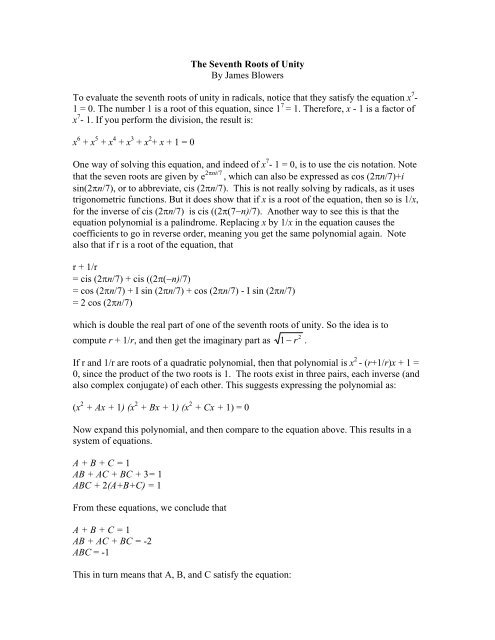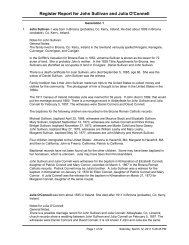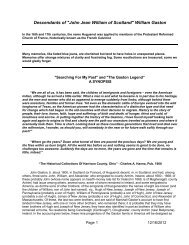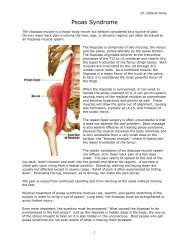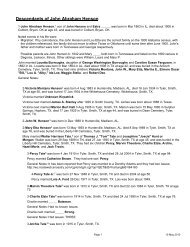The Seventh Roots of Unity - Jim Blowers' Web Page
The Seventh Roots of Unity - Jim Blowers' Web Page
The Seventh Roots of Unity - Jim Blowers' Web Page
Create successful ePaper yourself
Turn your PDF publications into a flip-book with our unique Google optimized e-Paper software.
<strong>The</strong> <strong>Seventh</strong> <strong>Roots</strong> <strong>of</strong> <strong>Unity</strong>By James BlowersTo evaluate the seventh roots <strong>of</strong> unity in radicals, notice that they satisfy the equation x 7 -1 = 0. <strong>The</strong> number 1 is a root <strong>of</strong> this equation, since 1 7 = 1. <strong>The</strong>refore, x - 1 is a factor <strong>of</strong>x 7 - 1. If you perform the division, the result is:x 6 + x 5 + x 4 + x 3 + x 2 + x + 1 = 0One way <strong>of</strong> solving this equation, and indeed <strong>of</strong> x 7 - 1 = 0, is to use the cis notation. Notethat the seven roots are given by e 2πni/7 , which can also be expressed as cos (2πn/7)+isin(2πn/7), or to abbreviate, cis (2πn/7). This is not really solving by radicals, as it usestrigonometric functions. But it does show that if x is a root <strong>of</strong> the equation, then so is 1/x,for the inverse <strong>of</strong> cis (2πn/7) is cis ((2π(7−n)/7). Another way to see this is that theequation polynomial is a palindrome. Replacing x by 1/x in the equation causes thecoefficients to go in reverse order, meaning you get the same polynomial again. Notealso that if r is a root <strong>of</strong> the equation, thatr + 1/r= cis (2πn/7) + cis ((2π(−n)/7)= cos (2πn/7) + I sin (2πn/7) + cos (2πn/7) - I sin (2πn/7)= 2 cos (2πn/7)which is double the real part <strong>of</strong> one <strong>of</strong> the seventh roots <strong>of</strong> unity. So the idea is tocompute r + 1/r, and then get the imaginary part as21 − r .If r and 1/r are roots <strong>of</strong> a quadratic polynomial, then that polynomial is x 2 - (r+1/r)x + 1 =0, since the product <strong>of</strong> the two roots is 1. <strong>The</strong> roots exist in three pairs, each inverse (andalso complex conjugate) <strong>of</strong> each other. This suggests expressing the polynomial as:(x 2 + Ax + 1) (x 2 + Bx + 1) (x 2 + Cx + 1) = 0Now expand this polynomial, and then compare to the equation above. This results in asystem <strong>of</strong> equations.A + B + C = 1AB + AC + BC + 3= 1ABC + 2(A+B+C) = 1From these equations, we conclude thatA + B + C = 1AB + AC + BC = -2ABC = -1This in turn means that A, B, and C satisfy the equation:
y 3 - y 2 - 2y + 1 = 0This cubic can be solved using the cubic formula. It is going to give real roots, but theformula will express them with complex numbers. That's how it happens. We cannotexpress them in real radicals.To solve the cubic, first replace y with x + 1/3. This gets rid <strong>of</strong> the second term, resultingin the equation:x3−73x +727= 0<strong>The</strong> formula is, where p = -7/3 and q = 7/27:q2q4p27q2q42 32x =3− + + +3− + +− 7 + 21i3 − 7 − 21i+5454=3333p27This gives x. To get y, remember we made the substitution, and note that 54/3 3 = 2:y =− 7 + 21i3 − 7 − 21i+3+223133This is only one <strong>of</strong> the roots <strong>of</strong> the cubic in y, and I have used an ambiguous notation -the cube root. <strong>The</strong>re are three possible cubic roots. What do I mean? In this expression Imean take the polar coordinates <strong>of</strong> what's under the cube root sign, and take one-third <strong>of</strong>the angle. If I choose the second radical to be the complex conjugate <strong>of</strong> the first, theresulting y is a real number, namely 2 cos (2π/7). One-half <strong>of</strong> this number is the real part<strong>of</strong> one <strong>of</strong> the seventh roots <strong>of</strong> unity. To express the other two roots, I would have to insertfactors <strong>of</strong> ω and ω 2 , and ω 2 and ω, to the cube roots above, where ω is one <strong>of</strong> thecomplex cube roots <strong>of</strong> unity.To get the imaginary part <strong>of</strong> the seventh roots <strong>of</strong> unity, use the fact that the modulus, orabsolute value, <strong>of</strong> the roots is 1. This means that the imaginary part z is:z =1 − y2=8 +3− 7 + 21i23+− 7 − 21i23 − 637 −147i+2543+3 3 3− 637 + 147i23
So an expression for the 7th roots <strong>of</strong> unity is:⎛⎜1+⎜⎜1 ⎜3 ⎜⎜⎜⎜+i⎝− 7 + 21i3 − 7 − 21i33+3222− 7 + 21i3 − 7 − 21i8 +3+221 −3 − 637 −147i+223+3 3 3− 637 + 147i23⎞⎟⎟⎟⎟⎟⎟⎟⎟⎠<strong>The</strong> real part <strong>of</strong> this root is a solution <strong>of</strong> a cubic equation, but I don't believe that theimaginary part is - it is the root <strong>of</strong> a sixth degree equation. A similar phenomenon existsfor the fifth roots <strong>of</strong> unity.To get all six roots, one takes all six possible combinations <strong>of</strong> the sign before the I in thesecond line and the ωs and ω 2 s as coefficients <strong>of</strong> the cube roots. Note that once you makea choice <strong>of</strong> ωs and ω 2 s in the real part, one must keep the same choice in the imaginarypart.To see what happened when I evaluated these roots, note that I solved a cubic equation.Adding on to the rational numbers (Q) the roots <strong>of</strong> this equation results in a degree 3extension (not degree 6, since when one adds one root, the other roots also appear in thefield). This is the splitting field <strong>of</strong> y 3 - y 2 - 2y + 1 = 0 over Q. This got me the real part <strong>of</strong>the complex roots. I then added i to this field, creating a degree 6 extension. Thisextension, obtained by adding the root <strong>of</strong> y 3 - y 2 - 2y + 1 = 0 and i to Q, is the splittingfield F <strong>of</strong> x 7 - 1 = 0 over Q. <strong>The</strong> Galois group <strong>of</strong> all automorphisms <strong>of</strong> F over Q that fixesQ is Z/6Z, the integers mod 6. In terms <strong>of</strong> the Galois group, I went from I to Z/3Z toZ/6Z.What I wonder is, what if you go up through Z/2Z instead? In that case, you have tocome up with some quadratic equation, and then express the polynomial as a cubic in thatfield. What I do know is that the number that you have to add to Q to get this quadraticextension is r + r 2 + r 4 , where the exponents are the quadratic residues <strong>of</strong> 7. This number−1 + i 7is .2


